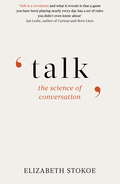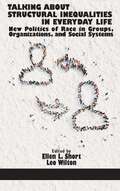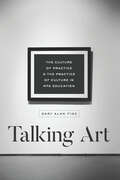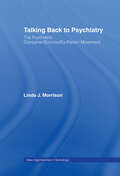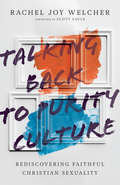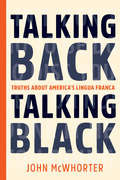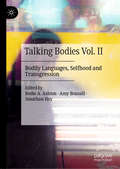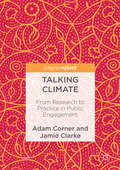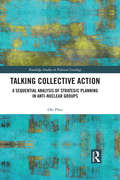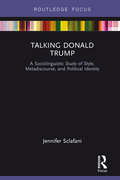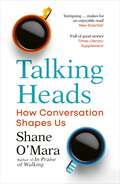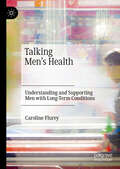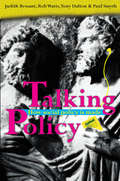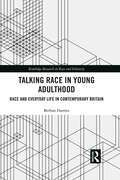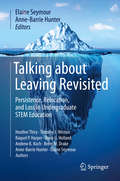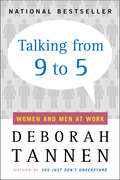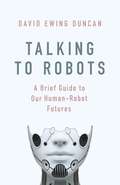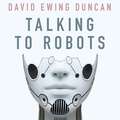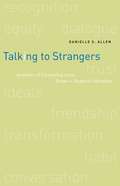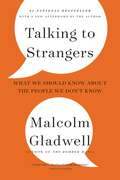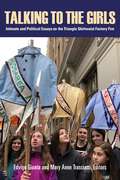- Table View
- List View
Talk: The Science of Conversation
by Elizabeth StokoeWe spend much of our days talking. Yet we know little about the conversational engine that drives our everyday lives. We are pushed and pulled around by language far more than we realize, yet are seduced by stereotypes and myths about communication.This book will change the way you think about talk. It will explain the big pay-offs to understanding conversation scientifically. Elizabeth Stokoe, a social psychologist, has spent over twenty years collecting and analysing real conversations across settings as varied as first dates, crisis negotiation, sales encounters and medical communication. This book describes some of the findings of her own research, and that of other conversation analysts around the world. Through numerous examples from real interactions between friends, partners, colleagues, police officers, mediators, doctors and many others, you will learn that some of what you think you know about talk is wrong. But you will also uncover fresh insights about how to have better conversations - using the evidence from fifty years of research about the science of talk.
Talk: The Science of Conversation
by Elizabeth StokoeWe spend much of our days talking. Yet we know little about the conversational engine that drives our everyday lives. We are pushed and pulled around by language far more than we realize, yet are seduced by stereotypes and myths about communication.This book will change the way you think about talk. It will explain the big pay-offs to understanding conversation scientifically. Elizabeth Stokoe, a social psychologist, has spent over twenty years collecting and analysing real conversations across settings as varied as first dates, crisis negotiation, sales encounters and medical communication. This book describes some of the findings of her own research, and that of other conversation analysts around the world. Through numerous examples from real interactions between friends, partners, colleagues, police officers, mediators, doctors and many others, you will learn that some of what you think you know about talk is wrong. But you will also uncover fresh insights about how to have better conversations - using the evidence from fifty years of research about the science of talk.
Talkabout Relationships: Building Self-Esteem and Relationship Skills (Talkabout #Vol. 3)
by Alex KellyThe third title in the successful "Talkabout" series, "Talkabout Relationships" reflects current literature and research on developing relationships for people with learning disabilities, and aims, through groupwork, to improve self-esteem and relationship skills in people who are having difficulties in making or maintaining friends. This highly illustrated, practical resource: is designed to help teachers or therapists to work through self-esteem and relationship skills within a group setting in a structured way. It was originally written for young adults with a learning disability, it has also been used successfully with children with learning disabilities and those who present with social skills difficulties. Includes a staff rating assessment of a client's relationship skills and criteria for inclusion in a relationships group, as well as a self-esteem assessment and a self-rating assessment of relationship skills. This title contains illustrated, photocopiable group activities and worksheets to address self-image, identity and self-confidence as well as the different types of relationship, the qualities of friends and some of the skills involved in improving and developing relationships. Illustrated by the author, this hands-on groupwork resource is ideal for speech language therapists, teachers, occupational therapists, community learning disability nurses and anyone working in the field of learning disability.
Talking About Structural Inequalities in Everyday Life: New Politics of Race in Groups, Organizations, and Social Systems
by Ellen L. Short Leo WiltonThe book, Talking About Structural Inequalities in Everyday Life: New Politics of Race in Groups, Organizations, and Social Systems, provides critical attention to contemporary, innovative, and cutting-edge issues in group, organizational, and social systems that address the complexities of racialized structural inequalities in everyday life. This book provides a comprehensive focus on systemic, societal, and organizational functioning in a variety of contexts in advancing the interdisciplinary fields of human development, psychology, counseling, social work, education, public health, multiculturalism/cultural studies, and organizational consultation. One of the most fundamental aspects of this book engages readers in the connection between theory and praxis that incorporates a critical analytic approach to learning and the practicality of knowledge. A critical emphasis examines how inequalities and power relations manifest in groups, organizations, communities, and social systems within societal contexts.
Talking About Welfare: Readings in Philosophy (Routledge Library Editions: Welfare and the State #22)
by David Watson Noel TimmsOriginally published in 1976 Talking About Welfare is a collection of essays providing a general survey of the problems facing social welfare. The book introduces a number of philosophers, social workers and social administrators, concentrating on problems in describing a general philosophical orientation to social work, what it means to understand another person, and to problems in describing and justifying social work and social welfare activity. The essays collected contribute to discussion of a wide range of welfare issues, principally that of personal and social welfare, the moral justification of welfare provision, and conceptions of community.
Talking Art: The Culture of Practice & the Practice of Culture in MFA Education
by Gary Alan FineIn Talking Art, acclaimed ethnographer Gary Alan Fine gives us an eye-opening look at the contemporary university-based master’s-level art program. Through an in-depth analysis of the practice of the critique and other aspects of the curriculum, Fine reveals how MFA programs have shifted the goal of creating art away from beauty and toward theory. Contemporary visual art, Fine argues, is no longer a calling or a passion—it’s a discipline, with an academic culture that requires its practitioners to be verbally skilled in the presentation of their intentions. Talking Art offers a remarkable and disconcerting view into the crucial role that universities play in creating that culture.
Talking Back to Psychiatry: The Psychiatric Consumer/Survivor/Ex-Patient Movement (New Approaches in Sociology)
by Linda J. MorrisonLinda Morrison brings the voices and issues of a little-known, complex social movement to the attention of sociologists, mental health professionals, and the general public. The members of this social movement work to gain voice for their own experience, to raise consciousness of injustice and inequality, to expose the darker side of psychiatry, and to promote alternatives for people in emotional distress. Talking Back to Psychiatry explores the movement's history, its complex membership, its strategies and goals, and the varied response it has received from psychiatry, policy makers, and the public at large.
Talking Back to Purity Culture: Rediscovering Faithful Christian Sexuality
by Rachel Joy WelcherIt's time to talk back. The generation born into evangelical purity culture has grown up, and many have started families of their own. But as time goes on, it's becoming more evident that many still struggle with purity culture's complicated legacy—its idolization of virginity, its mixed messages about modesty and lust, and its promise of a healthy marriage and great sex for those who follow the rules. In Talking Back to Purity Culture, Rachel Joy Welcher reviews the movement carefully, examining its teachings through the lens of Scripture. Compassionate, faithful, and wise, she charts a path forward for Christians in the ongoing debates about sexuality—one that rejects legalism and license alike, steering us back instead to the good news of Jesus. It's time to talk back to purity culture—and this book is ready to jump-start the conversation.
Talking Back, Talking Black: Truths About America's Lingua Franca
by John Mcwhorter"One of our sharpest explainers of linguistics." -Steven Pinker"In Talking Back, Talking Black, John McWhorter, the maestro at communicating linguistics to the public, succeeds in helping the reader to 'actually hear Black English in a new way,' while hipping linguists to some features of this vibrant variety they might not have considered before." -John R. Rickford, former president of the Linguistic Society of America and coauthor of Spoken Soul: The Story of Black English"McWhorter debunks some of our most persistent myths about language." -NPR"McWhorter makes all the right arguments, and he makes them clearly." -New Yorker"Do you think Black English is a 'dialect' full of 'mistakes'? You're likely to change your mind about its 'languageness' after reading Mr. McWhorter." -Wall Street JournalIt has now been almost fifty years since linguistic experts began studying Black English as a legitimate speech variety, arguing to the public that it is different from Standard English, not a degradation of it. Yet false assumptions and controversies still swirl around what it means to speak and sound "black." In his first book devoted solely to the form, structure, and development of Black English, John McWhorter clearly explains its fundamentals and rich history, while carefully examining the cultural, educational, and political issues that have undermined recognition of this transformative, empowering dialect. Talking Back, Talking Black takes us on a fascinating tour of a nuanced and complex language that has moved beyond America's borders to become a dynamic force for today's youth culture around the world.John McWhorter teaches linguistics, Western civilization, music history, and American studies at Columbia University. A New York Times best-selling author and TED speaker, he is a columnist for Time and regular contributor to the Atlantic, Wall Street Journal, and Washington Post. His books on language include The Power of Babel, Our Magnificent Bastard Tongue, What Language Is, The Language Hoax, and Words on the Move.
Talking Bodies Vol. II: Bodily Languages, Selfhood and Transgression
by Bodie A. Ashton Amy Bonsall Jonathan HayThis volume brings together scholars from across disciplines and continents in order to continue to analyse, query, and deconstruct the complexities of bodily existence in the modern world. Comprising nine essays by leading and emerging scholars, and spanning issues ranging from literature, history, sociology, medicine, law and justice and beyond, Talking Bodies vol. II is a timely and prescient addition to the vital discussion of what bodies are, how we perceive them, and what they mean. As the essays of this volume demonstrate, it is imperative to question numerous established presumptions about both the manner by which our bodies perform their identities, and the processes by which their ownership can be impinged upon.
Talking Climate: From Research to Practice in Public Engagement
by Adam Corner Jamie ClarkeThis book describes a fresh approach to climate change communication: five core principles for public engagement that can propel climate change discourse out of the margins and into the mainstream. The question of how to communicate about climate change, and build public engagement in high-consuming, carbon-intensive Western nations, has occupied researchers, practitioners, and campaigners for more than two decades. During this time, limited progress has been made. Socially and culturally, climate change remains the preserve of a committed but narrow band of activists. Public engagement is stuck in second gear. By spanning the full width of the space between primary academic research and campaign strategies, this book will be relevant for academics, educators, campaigners, communicators and practitioners.
Talking Collective Action: A Sequential Analysis of Strategic Planning in Anti-Nuclear Groups (Routledge Studies in Political Sociology)
by Ole PützAn ethnographic study of anti-nuclear movement groups that both challenges assumptions of traditional social movement studies of strategic action and shows what can be gained through microanalysis of talk in meetings, this book advances social movement studies methodologically and theoretically through the application of a new method of sequential analysis. Drawing on both conversation analysis and objective hermeneutics, it builds on microanalysis to scale up from sequences of talk to meetings, from meetings to groups, and from groups to the anti-nuclear movement, thus addressing a common criticism of analyses of face-to-face interactions: that they fail to demonstrate how their findings are relevant for questions beyond the interaction itself and thus for a broader sociological audience. A demonstration of the ways in which strategic deliberations by activists are subject to dynamics of face-to-face interaction, Talking Collective Action shows how groups adopt different styles of planning to engage with their environment and affect the groups’ development over time. As such, it will appeal to social scientists with interests in social movements, organizations and conversation analysis.
Talking Cure: An Essay on the Civilizing Power of Conversation
by Paula Marantz CohenAn invigorating exploration of the pleasures and social benefits of conversationTalking Cure is a timely and enticing excursion into the art of good conversation. Paula Marantz Cohen reveals how conversation connects us in ways that social media never can and explains why simply talking to each other freely and without guile may be the cure to what ails our troubled society.Drawing on her lifelong immersion in literature and culture and her decades of experience as a teacher and critic, Cohen argues that we learn to converse in our families and then carry that knowledge into a broader world where we encounter diverse opinions and sensibilities. She discusses the role of food in encouraging conversation, the challenges of writing dialogue in fiction, the pros and cons of Zoom, the relationship of conversation to vaudeville acts, and the educational value of a good college seminar where students learn to talk about ideas. Cohen looks at some of the famous groups of writers and artists in history whose conversation fed their creativity, and details some of the habits that can result in bad conversation.Blending the immediacy of a beautifully crafted memoir with the conviviality of an intimate gathering with friends, Talking Cure makes a persuasive case for the civilizing value of conversation and is essential reading for anyone interested in the chatter that fuels culture.
Talking Donald Trump: A Sociolinguistic Study of Style, Metadiscourse, and Political Identity (Routledge Focus on Linguistics)
by Jennifer SclafaniTalking Donald Trump examines the language of Donald Trump’s presidential campaign from the perspective of sociocultural linguistics. This book offers an insight into the many stages of Trump’s political career, from his initial campaign for the Republican nomination, up to his presidency. Drawing from speeches, debates, and interviews, as well as parodies and public reactions to his language, Sclafani explores how Trump’s language has produced such polarized reactions among the electorate. In analysing the linguistic construction of Donald Trump’s political identity, Sclafani’s incisive study sheds light on the discursive construction of political identity and the conflicting language ideologies associated with the discourse of leadership in modern US society. Talking Donald Trump provides a crucial contemporary example of the interaction between sociolinguistics and political science, and is key reading for advanced students and researchers in the fields of sociolinguistics, language and politics, communication studies and rhetoric.
Talking Heads: The New Science of How Conversation Shapes Our Worlds
by Shane O'MaraFrom neurons to nations, Talking Heads is a stunning survey of the science of human connection and communication.'Delightfully well-written' IRISH TIMES'Intriguing ... Makes for an enjoyable read' NEW SCIENTIST'Full of good stories' TIMES LITERARY SUPPLEMENTTalking to each other is a primal behaviour. It’s a key part of what makes us human. Yet the science of human connection has largely remained a mystery. Only recently have scientific advances allowed us to peer into the purpose of conversations and uncover their extraordinary impact.In this groundbreaking book, the first of its kind written by a leading neuroscientist, Professor Shane O’Mara expertly reveals how talking affects all our lives. What does it mean that we mostly think, and speak, in five-minute bubbles around the present moment? Is the fact that we instinctively trust what others say empowering or a hindrance? And how do our very nations begin as conversations?Moving from the personal to the social and ultimately towards an urgent and radical new perspective on the defining phenomenon of our times, populist nationalism, Talking Heads is the story of how conversation shapes us and constructs our worlds – and how, together, we can talk our way into a better tomorrow.
Talking Men's Health: Understanding and Supporting Men with Long-Term Conditions
by Caroline FlureyThis book explores male health psychology in relation to chronic health conditions. Using data from men with rheumatic diseases as a starting point, this book draws on the wider literature to focus on how men talk about different aspects of living with long-term health issues. This includes how men discuss the impact of chronic illness on their sense of control and self-reliance, masculine identity, body image, mental health, sex and intimacy, and for those living with a life-limiting condition how they discuss facing their mortality. It also covers how men self-manage and what influences their help-seeking behaviours. Whilst men are often branded as ‘hard to reach’, the author argues that when given permission and provided with the right environment, men will talk about their health. This book takes the stance men are under-served by health services and includes suggestions for developing support services for health and mental health that meet men’s needs and preferences. Focussing on the experiences and support needs of men with long-term conditions, this is an ideal reading for clinicians, healthcare professionals, and practitioners working with men with long-term conditions, as well as early career researchers and students interested in male psychology, men’s health, and gender and society.
Talking Policy: How social policy is made
by Rob Watts Judith Bessant Paul Smyth Tony DaltonWhen we catch a bus, visit a doctor, borrow a book from the library or enrol in a course we benefit from the social policies of government. Talking Policy explains how the myriad programs and services we take for granted are developed and delivered, and how this fits into the political process. There is a human and political aspect to social policy-making; it's not all rational solutions to measurable problems. The authors explain how issues come to be defined as social problems, and offer an account of the historical development of social policy and the welfare state in Australia. They also outline the competing political and philosophical ideas which influence the different ways in which governments respond to social inequality and needs in the community.With detailed case studies from variety of areas of social policy making, Talking Policy is a valuable introduction to this complex and important field. 'Talking Policy is an informative, insightful book that is also absorbing and challenging.'Lois Bryson, Emeritus Professor, University of Newcastle'With a commitment to reinvigorate policy debate, the authors make a convincing case that at its heart policy-making is about competing ethical visions, that ideas count, and that words serve as tools in this political and contested activity.'Associate Professor, Carol Bacchi, University of Adelaide
Talking Race in Young Adulthood: Race and Everyday Life in Contemporary Britain (Routledge Research in Race and Ethnicity)
by Bethan HarriesAt a time in which race lies at the heart of so much public debate, Talking Race in Young Adulthood comes at an important moment. Drawing on ethnographic research with young adults in Manchester, Harries engages with ideas of the post-racial to explore how young adults make sense of their identities, relationships and new forms of racism, consequently revealing how and in what ways race remains a salient dimension of social experience. Indeed, this book presents news ways of thinking about how we live with difference, as Harries analyses the relationship between racism, generational identities and the spatial configurations of a city. Offering a distinct contribution to the sociology of race, this book will appeal to undergraduate and postgraduate students interested in fields such as Race and Ethnicity, Urban Sociology, Human Geography, Youth Studies, Cultural Studies and Social Anthropology.
Talking about Leaving Revisited: Persistence, Relocation, and Loss in Undergraduate STEM Education
by Heather Thiry Timothy J. Weston Raquel P. Harper Dana G. Holland Andrew K. Koch Brent M. DrakeTalking about Leaving Revisited discusses findings from a five-year study that explores the extent, nature, and contributory causes of field-switching both from and among “STEM” majors, and what enables persistence to graduation. The book reflects on what has and has not changed since publication of Talking about Leaving: Why Undergraduates Leave the Sciences (Elaine Seymour & Nancy M. Hewitt, Westview Press, 1997). With the editors’ guidance, the authors of each chapter collaborate to address key questions, drawing on findings from each related study source: national and institutional data, interviews with faculty and students, structured observations and student assessments of teaching methods in STEM gateway courses. Pitched to a wide audience, engaging in style, and richly illustrated in the interviewees’ own words, this book affords the most comprehensive explanatory account to date of persistence, relocation and loss in undergraduate sciences.Comprehensively addresses the causes of loss from undergraduate STEM majors—an issue of ongoing national concern.Presents critical research relevant for nationwide STEM education reform efforts.Explores the reasons why talented undergraduates abandon STEM majors.Dispels popular causal myths about why students choose to leave STEM majors.This volume is based upon work supported by the Alfred P. Sloan Foundation Award No. 2012-6-05 and the National Science Foundation Award No. DUE 1224637.
Talking from 9 to 5: Women and Men at Work
by Deborah Tannen“Required reading…sharp and insightful…lively and straightforward…a novel and sometimes startling analysis of workplace dynamics.”—New York Times Book ReviewIn her extraordinary international bestseller, You Just Don’t Understand, Deborah Tannen transformed forever the way we look at intimate relationships between women and men. Now she turns her keen ear and observant eye toward the workplace—where the ways in which men and women communicate can determine who gets heard, who gets ahead, and what gets done. An instant classic, Talking From 9 to 5 brilliantly explains women’s and men’s conversational rituals—and the language barriers we unintentionally erect in the business world. It is a unique and invaluable guide to recognizing the verbal power games and miscommunications that cause good work to be underappreciated or go unnoticed—an essential tool for promoting more positive and productive professional relationships among men and women.
Talking to Robots: A Brief Guide to Our Human-Robot Futures
by David Ewing DuncanOne of Time magazine's '32 Books You Need to Read This Summer' -- 'a riveting read'.'Intensely readable, downright terrifying, and surprisingly uplifting.'Vanity Fair'A fascinating work of imaginative futurology, a science journalist takes a look at our current technologies and anticipates the human-robot future that could await us - one full of warrior bots, politician bots, doctor bots and sex bots.'One of Barbara VanDenburgh's '5 Books Not to Miss', USA TodayOne of the best summer reads of 2019, according to top authors David Baldacci and Elizabeth Acevedo on USA Today's Today programme. 'A refreshing variation on the will-intelligent-robots-bring-Armageddon genre . . . this colorful mixture of expert futurology and quirky speculation does not disappoint' Kirkus ReviewsWhat robot and AI systems are being built and imagined right now? What do they say about us, their creators? Will they usher in a fantastic new future, or destroy us? What do some of our greatest thinkers, from physicist Brian Greene and futurist Kevin Kelly to inventor Dean Kamen, geneticist George Church and filmmaker Tiffany Shlain, anticipate for our human-robot future? For even as robots and AI intrigue us and make us anxious about the future, our fascination with robots has always been about more than the potential of the technology - it also concerns what robots tell us about being human.From present-day Facebook and Amazon bots to near-future 'intimacy' bots and 'the robot that swiped my job' bots, bestselling American popular science writer David Ewing Duncan's Talking to Robots is a wonderfully entertaining and insightful guide to possible future scenarios about robots, both real and imagined.Featured bots include robot drivers; doc bots; politician bots; warrior bots; sex bots; syntheticbio bots; dystopic bots that are hopefully just bad dreams; and ultimately, God Bot (asdescribed by physicist Brian Greene). These scenarios are informed by discussions with well-known thinkers, engineers, scientists, artists, philosophers and others, who share with us their ideas, hopes and fears about robots. David spoke with, among others, Kevin Kelly, David Baldacci, Brian Greene, Dean Kamen, Craig Venter, Stephanie Mehta, David Eagleman, George Poste, George Church, General R. H. Latiff, Robert Seigel, Emily Morse, David Sinclair, Ken Goldberg, Sunny Bates, Adam Gazzaley, Tim O'Reilly, Tiffany Shlain, Eric Topol and Juan Enriquez.These discussions, along with some reporting on bot-tech, bot-history and real-time societal andethical issues with robots, are the launch pads for unfurling possible bot futures that are informed by how people and societies have handled new technologies in the past.The book describes how robots work, but its primary focus is on what our fixation with botsand AI says about us as humans: about our hopes and anxieties; our myths, stories, beliefs andideas about beings both real and artificial; and our attempts to attain perfection.We are at a pivotal moment when our ancient infatuation with human-like beings with certainattributes or superpowers - in mythology, religion and storytelling - is coinciding with ourability to actually build some of these entities.
Talking to Robots: A Brief Guide to Our Human-Robot Futures
by David Ewing DuncanOne of Time magazine's '32 Books You Need to Read This Summer' -- 'a riveting read'.'Intensely readable, downright terrifying, and surprisingly uplifting.'Vanity Fair 'A fascinating work of imaginative futurology, a science journalist takes a look at our current technologies and anticipates the human-robot future that could await us - one full of warrior bots, politician bots, doctor bots and sex bots.'One of Barbara VanDenburgh's '5 Books Not to Miss', USA Today One of the best summer reads of 2019, according to top authors David Baldacci and Elizabeth Acevedo on USA Today's Today programme. 'A refreshing variation on the will-intelligent-robots-bring-Armageddon genre . . . this colorful mixture of expert futurology and quirky speculation does not disappoint' Kirkus ReviewsWhat robot and AI systems are being built and imagined right now? What do they say about us, their creators? Will they usher in a fantastic new future, or destroy us? What do some of our greatest thinkers, from physicist Brian Greene and futurist Kevin Kelly to inventor Dean Kamen, geneticist George Church and filmmaker Tiffany Shlain, anticipate for our human-robot future? For even as robots and AI intrigue us and make us anxious about the future, our fascination with robots has always been about more than the potential of the technology - it also concerns what robots tell us about being human.From present-day Facebook and Amazon bots to near-future 'intimacy' bots and 'the robot that swiped my job' bots, bestselling American popular science writer David Ewing Duncan's Talking to Robots is a wonderfully entertaining and insightful guide to possible future scenarios about robots, both real and imagined.Featured bots include robot drivers; doc bots; politician bots; warrior bots; sex bots; syntheticbio bots; dystopic bots that are hopefully just bad dreams; and ultimately, God Bot (asdescribed by physicist Brian Greene). These scenarios are informed by discussions with well-known thinkers, engineers, scientists, artists, philosophers and others, who share with us their ideas, hopes and fears about robots. David spoke with, among others, Kevin Kelly, David Baldacci, Brian Greene, Dean Kamen, Craig Venter, Stephanie Mehta, David Eagleman, George Poste, George Church, General R. H. Latiff, Robert Seigel, Emily Morse, David Sinclair, Ken Goldberg, Sunny Bates, Adam Gazzaley, Tim O'Reilly, Tiffany Shlain, Eric Topol and Juan Enriquez.These discussions, along with some reporting on bot-tech, bot-history and real-time societal andethical issues with robots, are the launch pads for unfurling possible bot futures that are informed by how people and societies have handled new technologies in the past.The book describes how robots work, but its primary focus is on what our fixation with botsand AI says about us as humans: about our hopes and anxieties; our myths, stories, beliefs andideas about beings both real and artificial; and our attempts to attain perfection.We are at a pivotal moment when our ancient infatuation with human-like beings with certainattributes or superpowers - in mythology, religion and storytelling - is coinciding with ourability to actually build some of these entities.
Talking to Strangers: Anxieties of Citizenship since Brown v. Board of Education
by Danielle S. Allen"Don't talk to strangers" is the advice long given to children by parents of all classes and races. Today it has blossomed into a fundamental precept of civic education, reflecting interracial distrust, personal and political alienation, and a profound suspicion of others. In this powerful and eloquent essay, Danielle Allen, a 2002 MacArthur Fellow, takes this maxim back to Little Rock, rooting out the seeds of distrust to replace them with "a citizenship of political friendship. "Returning to the landmark Brown v. Board of Education decision of 1954 and to the famous photograph of Elizabeth Eckford, one of the Little Rock Nine, being cursed by fellow "citizen" Hazel Bryan, Allen argues that we have yet to complete the transition to political friendship that this moment offered. By combining brief readings of philosophers and political theorists with personal reflections on race politics in Chicago, Allen proposes strikingly practical techniques of citizenship. These tools of political friendship, Allen contends, can help us become more trustworthy to others and overcome the fossilized distrust among us. Sacrifice is the key concept that bridges citizenship and trust, according to Allen. She uncovers the ordinary, daily sacrifices citizens make to keep democracy working and offers methods for recognizing and reciprocating those sacrifices. Trenchant, incisive, and ultimately hopeful, Talking to Strangers is nothing less than a manifesto for a revitalized democratic citizenry.
Talking to Strangers: What We Should Know about the People We Don't Know
by Malcolm GladwellMalcolm Gladwell, host of the podcast Revisionist History and author of the #1 New York Times bestseller Outliers, offers a powerful examination of our interactions with strangers--and why they often go wrong. <P><P>How did Fidel Castro fool the CIA for a generation? Why did Neville Chamberlain think he could trust Adolf Hitler? Why are campus sexual assaults on the rise? Do television sitcoms teach us something about the way we relate to each other that isn't true? <P><P>Talking to Strangers is a classically Gladwellian intellectual adventure, a challenging and controversial excursion through history, psychology, and scandals taken straight from the news. He revisits the deceptions of Bernie Madoff, the trial of Amanda Knox, the suicide of Sylvia Plath, the Jerry Sandusky pedophilia scandal at Penn State University, and the death of Sandra Bland---throwing our understanding of these and other stories into doubt. <P><P>Something is very wrong, Gladwell argues, with the tools and strategies we use to make sense of people we don't know. And because we don't know how to talk to strangers, we are inviting conflict and misunderstanding in ways that have a profound effect on our lives and our world. In his first book since his #1 bestseller, David and Goliath, Malcolm Gladwell has written a gripping guidebook for troubled times. <P><P><b>A New York Times Bestseller</b>
Talking to the Girls: Intimate and Political Essays on the Triangle Shirtwaist Factory Fire
by Edvige Giunta and Mary Anne TrasciattiCandid and intimate accounts of the factory-worker tragedy that shaped American labor rights On March 25, 1911, a fire broke out on the eighth floor of the Asch Building in Greenwich Village, New York. The top three floors housed the Triangle Waist Company, a factory where approximately 500 workers, mostly young immigrant women and girls, labored to produce fashionable cotton blouses, known as “waists.” The fire killed 146 workers in a mere 15 minutes but pierced the perpetual conscience of citizens everywhere. The Asch Building had been considered a modern fireproof structure, but inadequate fire safety regulations left the workers inside unprotected. The tragedy of the fire, and the resulting movements for change, were pivotal in shaping workers' rights and unions. A powerful collection of diverse voices, Talking to the Girls: Intimate and Political Essays on the Triangle Fire brings together stories from writers, artists, activists, scholars, and family members of the Triangle workers. Nineteen contributors from across the globe speak of a singular event with remarkable impact. One hundred and eleven years after the tragic incident, Talking to the Girls articulates a story of contemporary global relevance and stands as an act of collective testimony: a written memorial to the Triangle victims.
